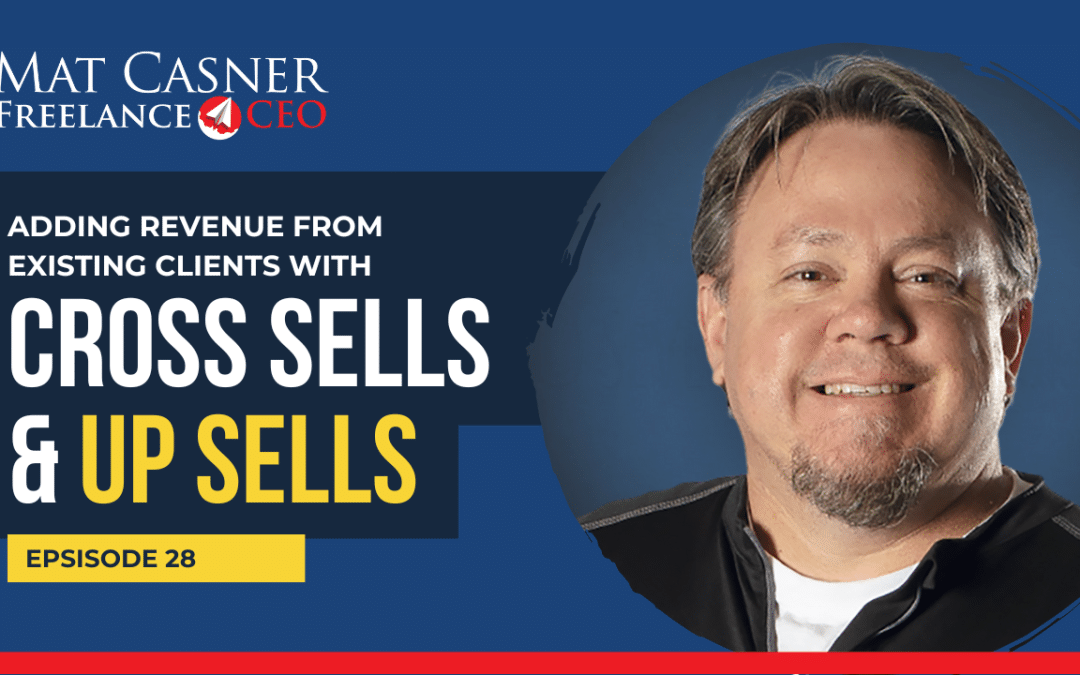
Today we’re gonna talk about cross-sells and upsells.
And a little story to kind of illustrate what I’m talking about is I was working for this client and they were coming to me with a quarterly project and it was a print project, and I was really excited to get the recurring work. Here’s kinda how the scenario would go. They would give me the project files, I would complete the design, and then toward the end of the project, the client would say, Matt, can you please forward the print files to our printer? And here’s the contact information. And I would do that.
Well, I have actually set up a relationship with a trade printer, and I have networks with other printers that, that I’ve done business with in the past. But it really never occurred to me to offer print services to my clients if they didn’t ask for it. And one day, when I was getting the call from the client to do another version of this document that we had been normally, you know, working on together as I was putting together my bid for them, I simply added at the end, by the way, would you like me to include some pricing for printing? Well, that opened up an entire new world for me. The client not only was interested in getting my print bid, they were actually excited because it gave them one less vendor to have to deal with.
So what that ended up being for me was an entirely new stream of revenue that I could use in my business. So today we’re gonna talk about how cross-sells and upsells can be a very strategic tool that you can use with existing clients, and I’ll show you how very powerful it can be. So first off, cross-selling or upselling is simply you giving your clients an opportunity to buy additional services from you that may be related to the services that you’re already providing.
For instance, in the example that I just shared, I was providing graphic design services. And so I basically cross-sell the print services. So that for me was, that’s not a big stretch, and they were both services that I’m providing. I just was only providing one to the client at time. I simply just offered the additional service to them.
Now, when you do this sort of thing, you give yourself the ability to really examine your entire suite of services and products and be able to find a natural fit with your client. So in this situation, I was able to, you know, bundle the design services that I had with the printing services that I could provide. Now, maybe a couple of other examples would be, maybe you’re a logo or a brand designer. Maybe you could offer them or cross sell, let’s say some collateral design, business card brochure, letterhead, stationary, or maybe even something bigger. But you would have that footing with that client. As a brand designer, you have their faith and trust and really, you know the brand better than anyone since you created it.
So it makes perfect sense that you would be able to cross sell or maybe even upsell into some additional products or services that you could offer this client and continue to work with them at an even greater level. Another example would be, let’s say you’re a web designer, and let’s say that you would like to be able to expand into some recurring revenue. So you could offer web hosting services to your customer.
You could upsell them on a web hosting package as a part of the, the web design that you’re doing. Again, you’re giving the customer one vendor to work with, and it’s making it easier for them because they only have to deal with one person. So this is the opportunity that you have to offer these clients some additional services and products. Now, number two, this process of upselling and cross-selling has kind of this secondary benefit. It really makes you a more valuable and versatile partner for your customer. Not only are they just hitting you for this one type of a project or service that you’ve come to do for your client, now you’re expanding that and their trust level is growing. So with more trust comes more responsibility, and with the more responsibility, then you’re going to have more revenue generating opportunities. This is a great place to be in if you’re looking to grow your business, but not really looking to go find a bunch of brand new clients. Guys, you’ve heard me say this before, it’s so much easier to sell to an existing client than it is to go out and find a new one.
And it’s so much less stressful to know that you have a customer that you do work with that trusts you and allows you to do additional work for them so you don’t have to go find someone else and go start a brand new client relationship with a total stranger. So it just makes sense. Now, another benefit for the client is this creates just greater convenience and less stress.
So we talk about the stress of feast or famine and how it’s hard for us guys when you talk about it from the client perspective. When a client is looking to get work done, they’re looking for a vendor that’s time out of their day, that’s them trying to manage multiple people, multiple vendors, multiple sources, and that creates stress in the the client’s mind.
So when we come in and can offer more services, we can help our customer have less stress because they’re not having to manage as many people. So that’s just a benefit that can come from working with a client offering multiple services. Now, the last thing I wanna talk about is how do you really get these cross-sell and upsell opportunities, especially if the client didn’t ask for it? Well, the client is only gonna ask for what they feel like they need or what they feel like you can provide. Don’t make the assumption that the client knows everything that you can do. What you do is you want to build trust with your client, and you wanna make sure that you are working with a client that you’re comfortable working with long term, but at the very, very heart of it, it’s simply asking a question. When you get a request for a project and it’s in your wheelhouse and you are analyzing the request and you see that there is maybe some opportunity to cross-sell and upsell, as you are filling out your response, all you simply have to say is, yes, I’d be happy to respond to this request.
Would you like for me to add a bid for this product or that service as well? And let them reply to you. If they say, great, then by all means, give them your pricing as a little bonus, a little pro tip, because you’re bundling these services, you might be able to offer them a little bit of a discount. That would be a great incentive for a customer who’s looking to consolidate the work and save some money.
So remember, cross-selling is all about offering complimentary skills and services that you have, and it’s about being more valuable, more versatile for your client. And all you have to do is ask.

